How to Create an Best Email Marketing Funnel For eCommerce? (With Templates)
Every online business fantasizes about getting more customers every day and making them loyal for as long as possible.
But why can’t every business live up to this fantasy? Because sometimes customers are like babies, they quickly lose interest or just disappear in the process.
As a digital marketer, you may have control over the steps you take to influence the customers, but how your leads act is not in your hands. You may tackle this problem with many activities, including hiring more in-house staff, advertising on social media or the Google Display Network, or putting money into the research and development department.
While all these practical activities exist, email marketing has also proven to be one of the most reliable tactics to influence leads at every stage of the buying journey.
However, if you don’t have a strategic plan on how you can move your leads to the next step using email marketing (or any tactic, for that matter), the rest of the journey for your customers may not happen at all.
This is where an email marketing funnel shows its worth.
The email marketing funnel works like a rail. It helps businesses get leads smoothly from point A to point B without worrying about them losing interest or getting lost. Information is the key here since companies can better know each customer’s stage and have the right offer.
In short, an email marketing funnel is an ultimate tool to influence potential consumers and drive them towards conversion goals using emails. If that sounds exciting, continue reading to see how you can guide your leads through the right part with email marketing.
What is an email marketing funnel?
A marketing funnel is the steps your visitor needs to go through before becoming a customer. It is a system designed to attract people to your business and convert them into customers.
In that system, an email marketing funnel is a presentation of how your subscribers go from lead to become customers through educational and promotional email communications. To have an effective email delivery channel, marketers must anticipate the needs of their subscribers to send emails at the right time to encourage action.
Why should you create an email marketing funnel? Well, the email list is one of the few marketing channels you truly own. While social networks are fantastic, you don’t have any control over these platforms. Just look at how rapidly social media platforms have changed their algorithms and rules over the past few years.
One of the best ways to invest in growing your email list (and profit) is by creating an email funnel for all your products, services, events, and more.
Better email marketing performance means higher revenue. To run successful email marketing campaigns in the funnel, automate and personalize your emails. Reach the right contact at the right time with the right content. That is the key.
Preparations for building an email marketing funnel
Now, if there’s one thing every funnel needs, it’s that you need traffic to go through the funnel. After all, how are your emails going to convert your customers on your offer when you have no one available when you present?
And an email marketing funnel is just like that. It needs to have subscribers to work. So where can you get those subscribers?
There are actually a bunch of different strategies you can use to grow your email list. But in general, the three easiest and most effective ways, which are newsletter opt-in forms, lead magnets, and demos/webinars.
Newsletters opt-ins forms
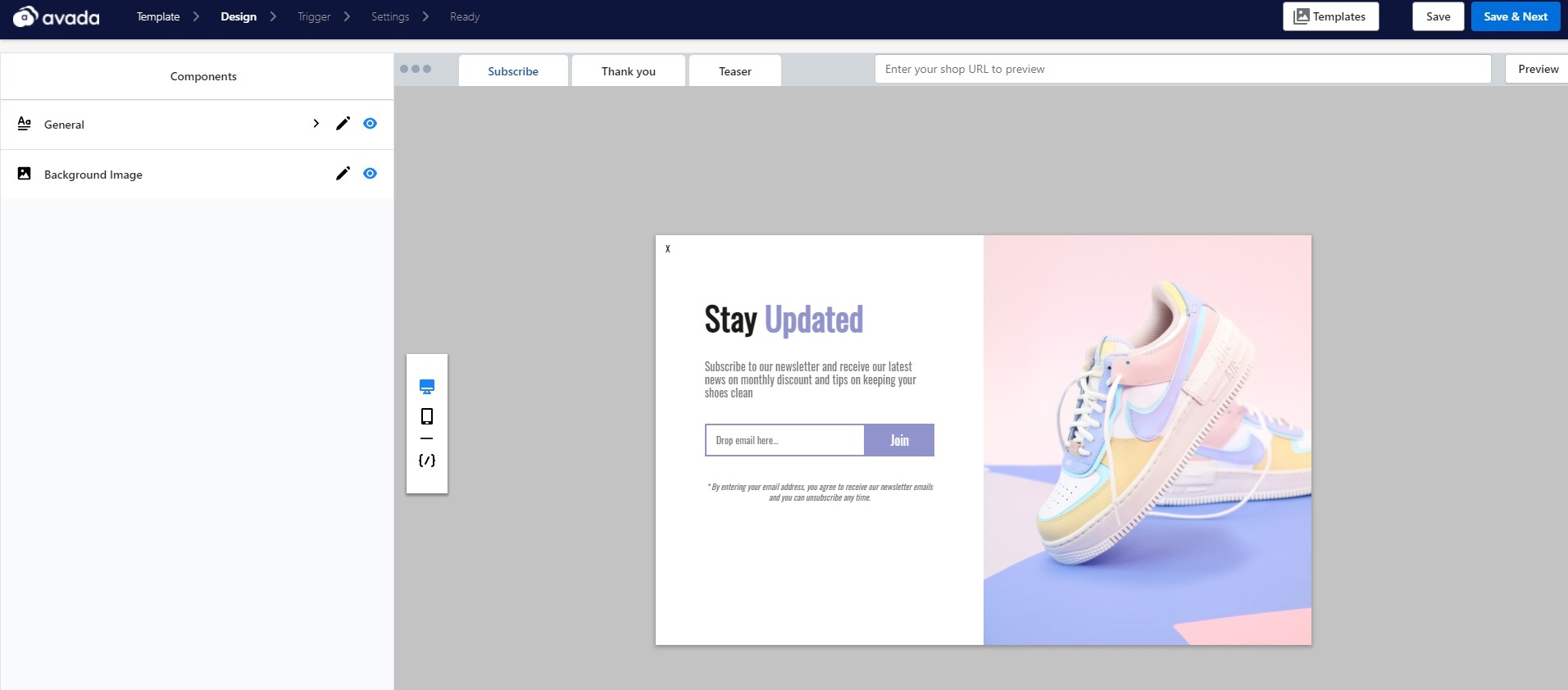
This is arguably the simplest traffic generating way to implement. You just need to slap a form right on your website and wait for visitors to turn into subscribers. Simple as that. Like the image above (taken from AVADA Email Marketing app), you can include an opt-in form on your eCommerce website and throughout many pages.
In order to have the highest rate of conversion possible with the newsletter opt-in form, you should treat every page like a landing page. Which means every page should have a call to action (CTA) and a bit of modification. Every page on your website should in some way or another try to push the audience towards taking an action.
So even your blog, your about us page, or your careers page should have some kinds of call to action. And including an opt-in form regularly is a fantastic way to turn every page into a marketing opportunity and grow your list.
But beware: your audience needs to actually love the content or deals you’re putting out. Because if they don’t, there is no reason for them to subscribe to your email list in the first place. You’ve got to offer value in the opt-in form by releasing consistent, quality content on your website’s blog.
Lead magnets
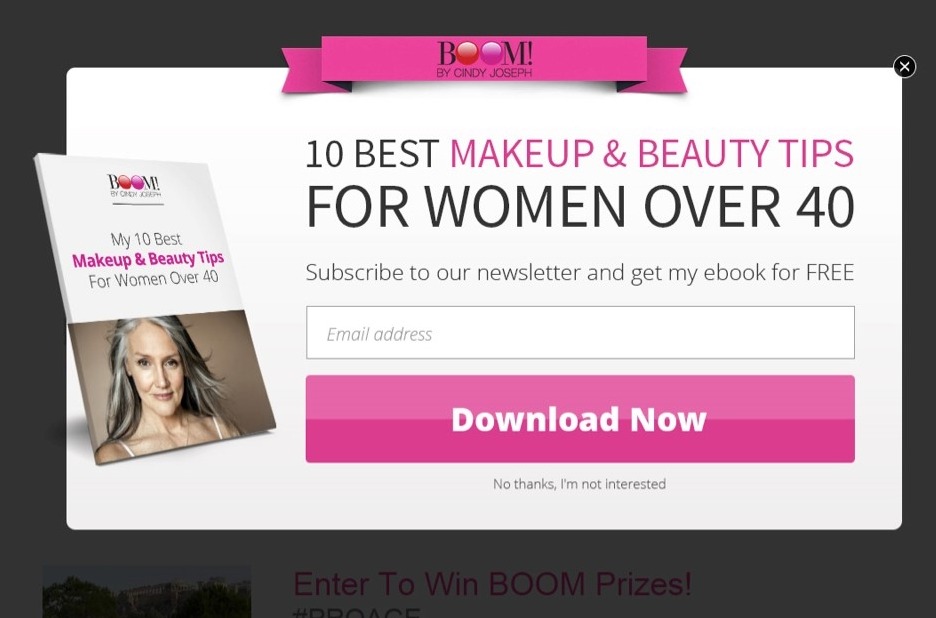
One alternative to the newsletter opt-in form is offering value up front right away with a lead magnet.
A lead magnet is any type of free and valuable content that you can offer your website visitors in exchange for some of their basic contact information (usually an email address).
They can have a super wide variety of forms too. Some of the most popular lead magnets can be named are:
-
eBook
-
Guides
-
Checklists
-
Whitepapers
-
Reports
-
Tutorials
-
Case Studies
-
Templates
-
Swipe Files
-
Video Training
-
Toolkits/Resource Lists
-
Quizzes/Surveys
Again, the key here is to have real value with your lead magnet. The more valuable the lead magnet is, the more likely visitors will be to give you their email addresses and click the download button. It’s also essential to explain that value by driving your visitors to a unique landing page.
Here, your audience can learn more about the lead magnet, see how relatable it is to their life/business, and decide whether or not to sign up. An email address in exchange for valuable information, that is usually a good enough deal to grow your business.
Demos/webinars

Finally, there’s the demos/webinars option.
If you’re at a place where your business can start teaching others how to solve certain types of problems, then offering a webinar can be one of the best options to increase awareness for your business and grow the email list. Demos are also fantastic to make prospects more familiar with your services or products. Webinar software has been used for years to conduct webinars. The benefits of using this type of system are that it’s easy, affordable and accessible as well.
You can even automate your demos and webinar to make things easier. On the other hand, if you have a service or product that can’t explain itself easily, then putting a demo video on your eCommerce website can be an amazing way to increase your conversions.
But in either case, gating this type of content first by asking for a name and email address from visitors is a great way to build an email list and prepare traffic for your email marketing funnel. Then, just relax and watch as your email list grows bigger.
That is what we do on our AVADA website, too. If a user would like to try out AVADA Email Marketing before choosing it for their business, they can request a demo by entering their name and email address to have custom pricing for their needs.
How to create the best email marketing funnel?
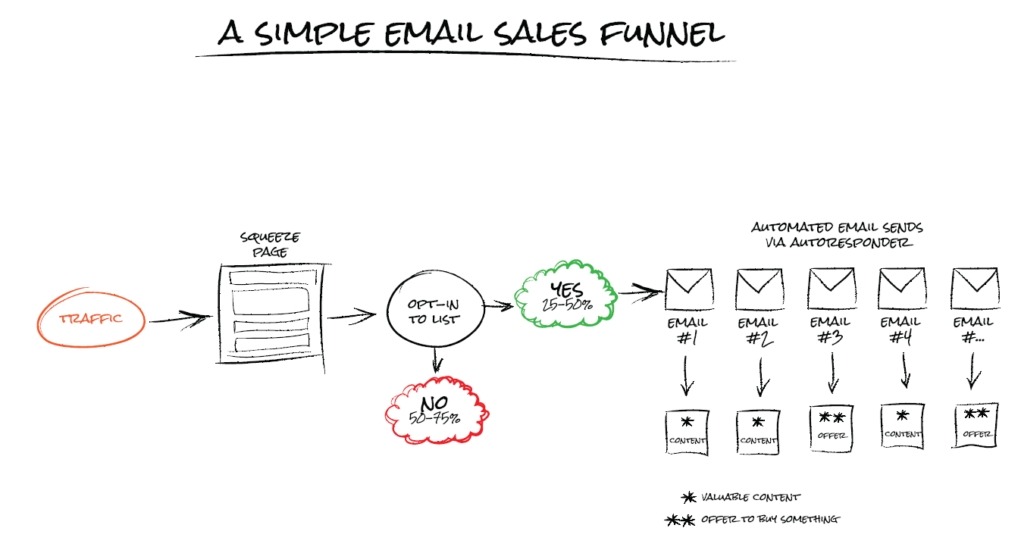
While there are countless ways to guide your subscribers through an email marketing funnel, these four basic steps are what you need to start engaging and retaining your leads.
Step 1: Generate leads through the top of the funnel
You may come across many marketers saying, “Money is on the list!” And, while it’s not the only stage in the email marketing funnel, it’s the start of a strong email marketing strategy. As explained above, unlike social media followers, you actually own your email list and have the most control over your email communication with them.
I don’t want to repeat myself here, so you already know which are the top three most effective lead generation tools to use. I just want to mention that beside optin forms, lead magnets, and demos/webinars, landing pages are also essential to create more leads.
Dedicated landing pages often pair with a lead magnet - like a free trial or an email course - educating users enough to get them into your sales cycle. Landing pages work because you’re providing value to your users, being a preview of what subscribers can expect from your email communications.
Step 2: Nurture leads and subscribers in the middle of the funnel
Once you’ve figured out a lead generation tactic to attract subscribers, you have to keep engaging with them. You can sement your lists to provide more relevant value propositions, products, reviews, and more for each subscriber. While this may sound complicated, a good email marketing automation platform such as AVADA Email Marketing can automatically segment your subscribers based on website or email behavior, lead magnets or the form they signed up for, or demographic information.
Lead nurturing emails need to be valuable, targeted, and customized to position you as a trusted brand that subscribers want to communicate. Every email is a new opportunity for your company to build relationships and help personalize your emails even more based on the prospects’ activities.
Some nurturing email examples for this stage are:
-
Customer success stories, case studies, and user-generated content.
-
Customized information and communication based on subscribers preferences.
-
Other free resources like blog posts, news, or webinars.
Step 3: Convert leads into customers at the bottom of the funnel
If your subscribers have passed the first two steps, you already have the leads ready for a big conversion. You have been building the relationship by providing value, which can result in an emotional response from your subscribers. At the bottom of the funnel in this step, you want to continue sending personalized and nurturing email campaigns with a more aggressive conversion tactic.
The final emails for conversion success include:
-
Retargeting: For your warmes leads, such as eCommerce cart abandoners, you can implement retargeting strategies to deliver automated emails containing the products they are interested in and encourage them to become paying customers.
-
Onboarding: if you already use a lead magnet called trial period, you can convert those free users into full paying customers when the free trial period is coming to an end with a bit of discount.
-
Time-sensitive offers: by giving potential customers a deadline in an urgent email, you’re giving them an obvious reason to convert. These emails can provide coupons, birthday offers, or exciting messages to subscribers who visit your eCommerce site over a long period of time.
Step 4: Retain customers to repeat the funnel
Even after a subscriber becomes a customer, your work is not done. Retaining customers and maintaining long-term loyalty is crucial in extending the long-term value of customers to increase your marketing ROI. Loyalty drives repeat purchases and referrals, which means you need to work to drive their next purchase once they convert. While you still use the same technique as the lead nurturing technique in step two, the message should be a little different because now you can talk about your brand and offers more directly.
Consider using the following emails to retain your customers:
-
Send upsell and cross sell emails based on your customer’s purchase history to promote bigger deals. The trick here is to not sound pushy and make your offers a better solution instead. You care for your customers, that is why you are sending this email.
-
Keep customers engaged with your products or services, whether it’s through technology updates or weekly progress reports, to stay at the top of your customers’ minds.
-
Offer loyalty referral campaigns that encourage word-of-mouth promotion and social sharing from your customers. Offers can include earning points to reduce the price of their next order or earning a free item.
Best Email Marketing Funnel templates
Now that we’ve covered how to create your best email marketing funnel, let’s look at what you can actually include in your email funnel. A good formula for your email marketing funnel is the key to build trust quickly and maximize the conversion rate. Here is a template consisting of 6 emails, forming a funnel to build trust and authority then inspire subscribers to act.
If you are just starting out, you can just use the first 3 emails to build an email marketing funnel and launch from there. The next three emails complete the formula, making your email sequence more effective. Let’s take a closer look at each of the email in the template
Email #1: Demonstrate your brand value
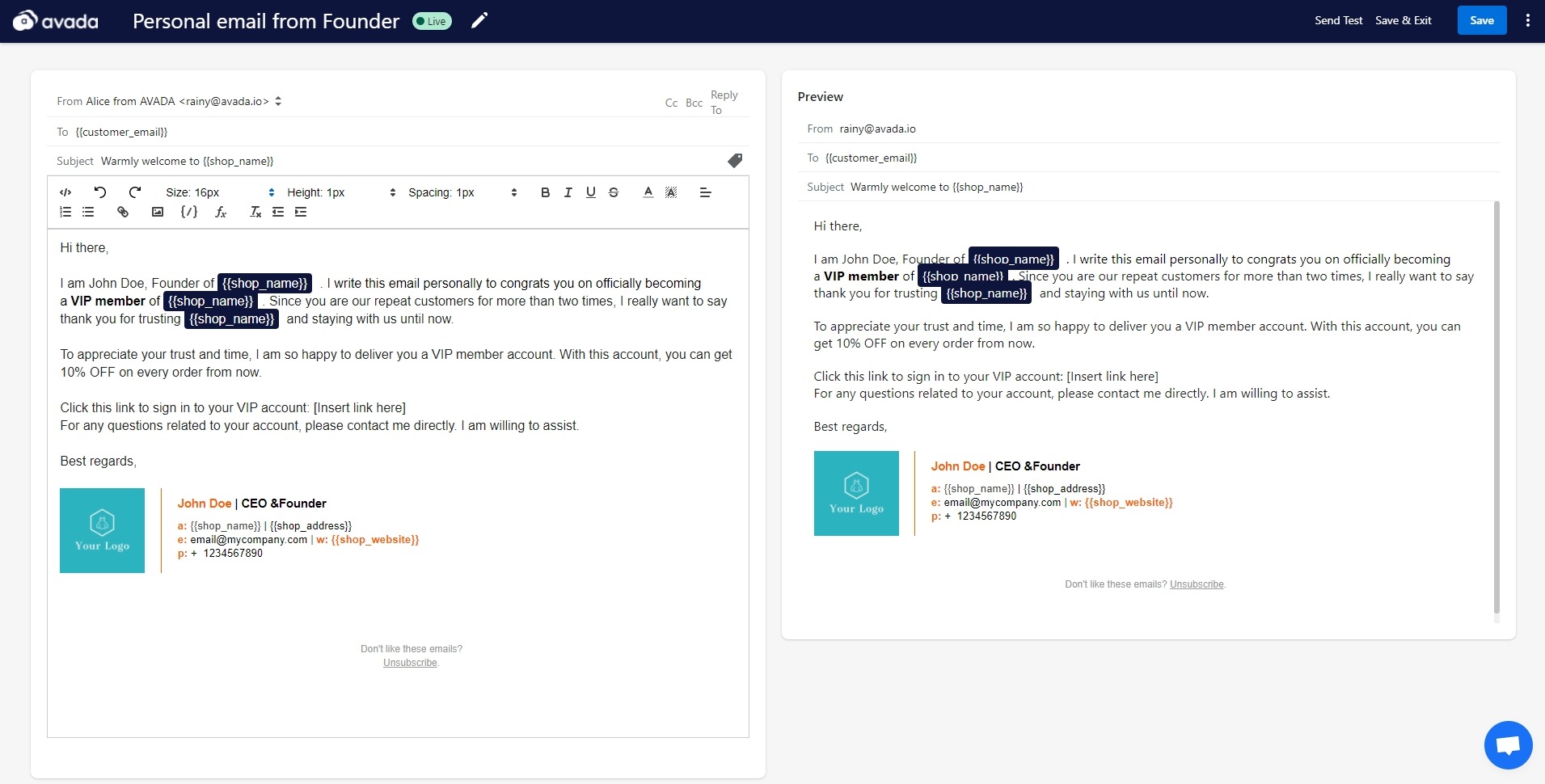
Your very first email in the funnel should aim to show value to the subscribers. Put the salesman hat back on the rack for a while, because more than anything, you should reassure recipients that they made the right decision by subscribing to your list. Not that they will regret receiving a bunch of garbage sales pitches.
After all, they are only a little aware of your products and services. Take this opportunity to build trust by pointing them to valuable things you have for them. Tutorial videos, guides, ebooks, blog posts - whatever you can offer to help subscribers learn more about their problems and your solutions (without hard-selling).
With AVADA Email Marketing, you can choose a heartfelt way such as offering a personal thank you email from the founder. This is a personalized email that can call out the recipient’s name and offer a small incentive for them to check out your products. More than that, subscribers can feel that they are having a real communication with a real person.
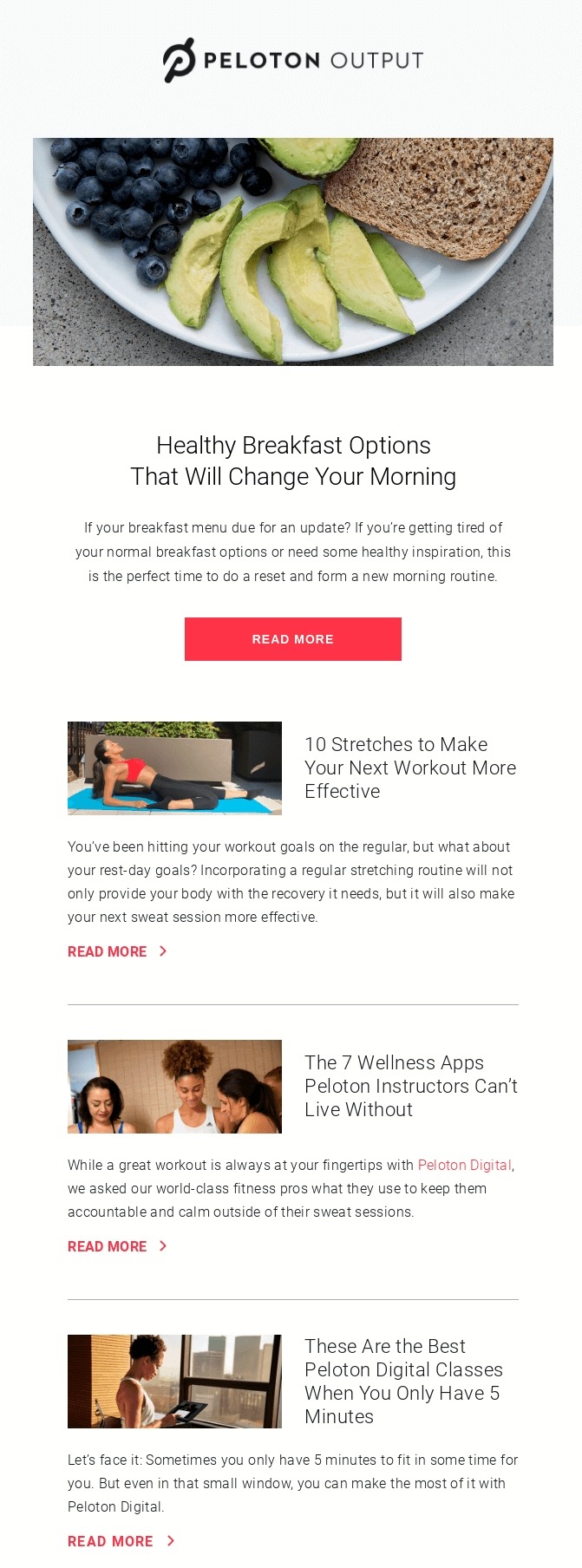
Or you can do it like Peloton by offering the subscribers blog posts on how to stay healthy. The email includes healthy breakfast options, stretch positions, and fitness apps for the users to continue their exercise. It’s a good example of a fantastic email that’s only focused on offering subscribers real value.
Email #2: Prove your brand’s authority
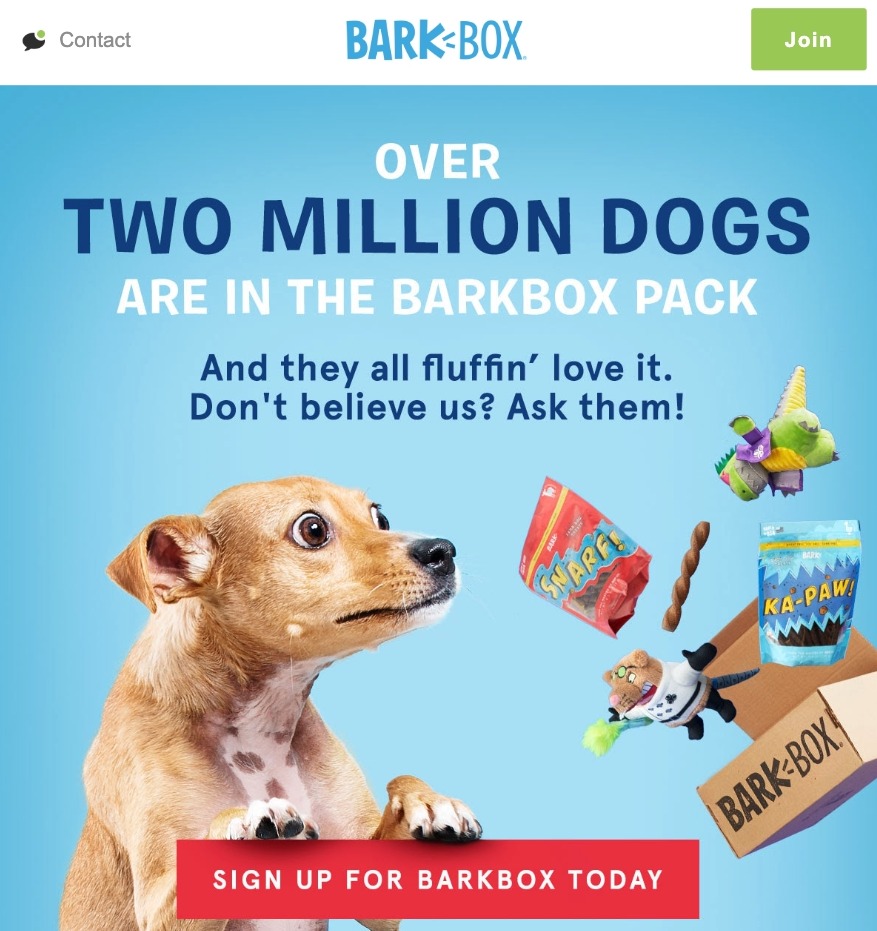
The next email focuses on establishing your brand as an authority. Why should subscribers trust the judgment in your emails? Why should they listen to your company at all?
This email helps answer those questions mainly by providing a range of social proof. Social proof is what you show your audience to prove that you are an expert on the industry, product, services, and your advice should be trusted.
And as any marketer knows, social proof is an incredibly powerful tool when it comes to convincing your audience to buy.
Now, social proof can come in many forms, such as showing customer testimonials, including statistics, or having trust badges from third-party companies. For example, in the email above from BarkBox, you can see how they showed that over two million dogs used their products.
Email #3: Make subscribers take action

Alright, now that you’ve nurtured your subscribers using email #1 and established your authority using email #2, it’s time to make the sales happen.
This email should aim to get your subscribers to take immediate action on what you have to offer. First and foremost, you must include a clear and super easy-to-find CTA button inside the email. Without a call to action, your subscribers would be lost on knowing what to do.
But beyond that, you also want to use something called “power words” in this email. A few worth mentioning examples are:
-
Actually
-
Imagine
-
Guarantee
-
Because
-
Introducing
-
Fast
But, ultimately, the best power word has gotta be “you.” People love hearing about themselves. They also love talking about themselves. And, of course, they love being appreciated. So when you use the word “you” to put the focus on the subscriber, you are driving serious conversions and immediate action.
Email design also plays an important role in making subscribers take action. If your CTAs are able to stand out and be clear in the actions to take, subscribers will be more likely to click on it. In our app AVADA Email Marketing, you can adjust your email design and the associated CTA, like in the image above, to perfection.
Email #4: Bring out your uniqueness
From here, the email #4 marks the point where you can add emails that aren’t required, but certainly can boost conversions.
Now that you’ve had the core of the email marketing funnel with the first three emails and start seeing results, you can start leveling up your email marketing game. In this #4 email, the goal is to bring out what makes your company unique. How can you stand out from your competitors?
One way to do that is by using language that can communicate the fact that you are different. This is the us vs. them tactic, and if you can do it well, it is a powerful email to convince your audience that your product is the right choice.
The other way, or one of the best ways to separate your brand from other companies is by pointing out your company’s core values and unique value proposition. Why did you create your unique service or products? What does your brand stand for? With this kind of messaging, the audience can understand your brand better and trust that you are the best on the market.
Email #5: Give a bit of scarcity and urgency to your offer
In this email, let’s take things up a notch and focus on conveying a sense of urgency in your message. One of the most obvious ways to do that is by pointing out that there is a limited-time sale for your subscribers.
Light the fire under the consumers’ butts by mentioning the date and time the sale is going to end. Plus, you can make use of a ticking clock timer that is continuously counting down. Black Friday, Christmas, Birthday, etc, there are many events that you can have a timer for sales.
Urgency’s cousin - scarcity is also highly effective in getting your subscribers clicking on the CTA. “First come first serve” or “limited supplies” are a few phrases that you can include in your emails when trying to convey scarcity.
Email #6: Hard sell and urge for a decision
Last but not least, sometimes a direct hard sell is just what you need to convince subscribers to take action.
This is where you should go all in with your offer and be blunt about selling your product or service with this email. You’ve spent 5 emails to build trust, establish credibility, and show your subscribers that you are the obvious choice. Now, let’s make the sales happen.
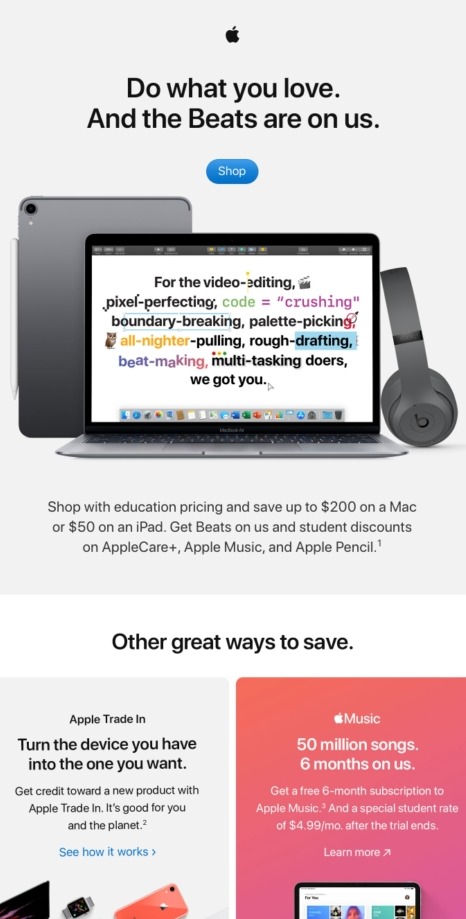
In this email, you can try out a tactic called “a deal that you can’t pass by”. You will have to put your best foot forward and push recipients on the fence to click the buy button. In the email example above from Apple, they immediately put the best deals forward in an email promoting Beats headphones.
Apple is literally the second most profitable company in the world, so they probably know their stuff in selling through emails. In this email, Apple mentioned that each purchase from students will qualify thema free pair of Beats headphones and a $200 discount on Macs and $50 discount on iPads.
If that is not enough to convince the students, they also offer a trade-in program and 6 months of using Apple Music for free below.
In this email, you can also remind subscribers of your company’s unique value proposition while offering a great deal on your products. Nobody can really tell which works best, but with an awesome deal in this email, it can be the final push your recipients need to start buying.
Final advice
The template above is not the only email marketing funnel that you can build for your online business. You can also build a funnel to gain more qualified leads, segment your audience, and create subsequent email sequences. But it’s not rocket science, you can build the best email marketing funnel for your business in no time with a bit of determination and the right mindset.
All you have to remember is that:
-
Fuel your email marketing funnel with quality subscribers
-
Understand the steps of building an email marketing funnel
-
Follow the steps and create necessary emails
-
Expand further down the funnel for more unique emails
-
Take advantage of a tool to segment your subscribers and create better follow up email sequences.
When you can add value to each of the emails in your funnel, a good result is guaranteed. Are you ready to take action? Contact me if you have any questions, and as always, best of luck with your eCommerce journey.
New Posts






